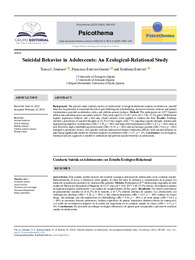Por favor, use este identificador para citar o enlazar este ítem:
https://hdl.handle.net/11000/37949Registro completo de metadatos
| Campo DC | Valor | Lengua/Idioma |
|---|---|---|
| dc.contributor.author | Jiménez Gutiérrez, Teresa Isabel | - |
| dc.contributor.author | Estévez-García, Francisco | - |
| dc.contributor.author | Estévez-López, Estefanía | - |
| dc.contributor.other | Departamentos de la UMH::Psicología de la Salud | es_ES |
| dc.date.accessioned | 2025-11-07T10:19:52Z | - |
| dc.date.available | 2025-11-07T10:19:52Z | - |
| dc.date.created | 2024-02 | - |
| dc.identifier.citation | Psicothema, Vol. 36, Nº4 (2024) | es_ES |
| dc.identifier.issn | 1886-144X | - |
| dc.identifier.issn | 0214-9915 | - |
| dc.identifier.uri | https://hdl.handle.net/11000/37949 | - |
| dc.description.abstract | Background: The present study analyzes factors of adolescents’ ecological-relational contexts in relation to suicidal behavior. In particular, it examined the role of peer bullying and cyberbullying, classroom climate, violence and partner victimization, parental socialization styles, and child-to-parent violence. Method: The participants are 2,977 Spanish adolescents attending seven secondary schools. They were aged 11-17 (M = 14.0, SD = 1.40; 51.5% girls). Multivariate logistic regression analyses and a two-step cluster analysis were applied to analyze the data. Results: Findings showed a prevalence of suicidal thoughts in 43.3% of the sample, with 7.7% reporting suicide attempts. Adolescents experiencing high/low victimization (ORa = 3.10, p < .001) and high cybervictimization (ORa = 1.67, p < .001) were at risk. However, high cyberbullying involvement (ORa = 0.55, p < .001) and not having a partner (ORa = 0.61, p < .001) emerged as protective factors. Sex-specific analyses underscored distinct interaction effects, with suicidal behavior in girls being significantly related to maternal negative socialization (ORa = 1.57, p = .05). Conclusions: An ecologicalrelational and sex approach is needed to understand and prevent suicidal behavior in adolescents. Antecedentes: Este estudio analiza factores del contexto ecológico-relacional de adolescentes en la conducta suicida. Particularmente, el acoso y ciberacoso entre iguales, el clima del aula, la violencia y victimización en la pareja, los estilos de socialización parental y la violencia filio-parental. Método: Participaron 2,977 adolescentes españoles de siete centros de Educación Secundaria Obligatoria de 11-17 años (M = 14.0; DT = 1.40; 51,5% chicas). Se realizaron análisis de regresión logística multivariada y un análisis de conglomerados de dos pasos. Resultados: Se observó prevalencia de pensamientos suicidas en el 43,3% de la muestra, y el 7,7% informó intentos de suicidio. Los adolescentes con victimización alta/baja (ORa = 3.10, p < .001) y alta cibervictimización (ORa = 1.67, p < .001) estaban en mayor riesgo. Sin embargo, una alta implicación en ciberbullying (ORa = 0.55, p < .001) y no tener pareja (ORa = 0.61, p < .001) se mostraron factores protectores. Análisis específicos de género subrayaron distintos efectos de interacción, y el estilo de socialización negativo en la madre fue importante en la conducta suicida en chicas (ORa = 1.57, p = .05). Conclusiones: Es necesario un enfoque ecológico-relacional y de género para comprender y prevenir la conducta suicida en adolescentes. | es_ES |
| dc.format | application/pdf | es_ES |
| dc.language.iso | eng | es_ES |
| dc.publisher | Colegio Oficial de Psicología del Principado de Asturias | es_ES |
| dc.rights | info:eu-repo/semantics/openAccess | es_ES |
| dc.rights | Attribution-NonCommercial-NoDerivatives 4.0 Internacional | * |
| dc.rights.uri | http://creativecommons.org/licenses/by-nc-nd/4.0/ | * |
| dc.subject | Conducta Suicida | es_ES |
| dc.subject | Acoso Escolar | es_ES |
| dc.subject | Violencia en el noviazgo | es_ES |
| dc.subject | Violencia filioparental | es_ES |
| dc.subject | Estilos parentales | es_ES |
| dc.subject | Suicidal behavior | es_ES |
| dc.subject | School Bullying | es_ES |
| dc.subject | Dating violence | es_ES |
| dc.subject | Child-to-parent violence | es_ES |
| dc.subject | Parental styles | es_ES |
| dc.subject.other | CDU::1 - Filosofía y psicología::159.9 - Psicología | es_ES |
| dc.title | Suicidal behavior in adolescents: an ecological-relational study | es_ES |
| dc.type | info:eu-repo/semantics/article | es_ES |
| dc.relation.publisherversion | https://doi. org/10.7334/psicothema2023.258 | es_ES |

Ver/Abrir:
Psicothema 2024.pdf
682,73 kB
Adobe PDF
Compartir:
 La licencia se describe como: Atribución-NonComercial-NoDerivada 4.0 Internacional.
La licencia se describe como: Atribución-NonComercial-NoDerivada 4.0 Internacional.
.png)